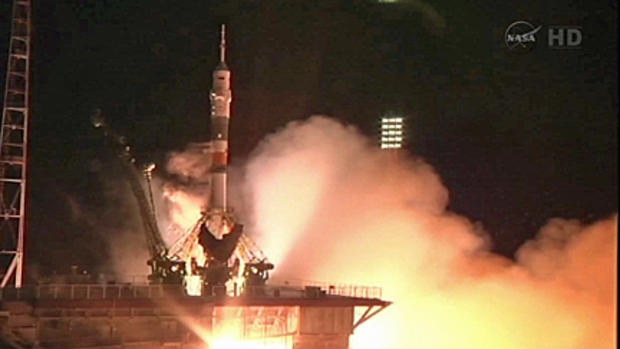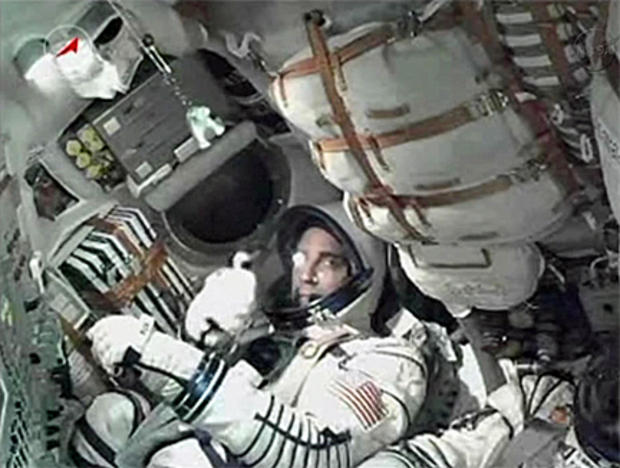Soyuz TMA-08M launches, docks with space station
-- Posted at 11:30 AM EDT, 03/28/13: Soyuz and three-man crew set for launch to space station
-- Corrected at 11:45 AM EDT, 03/28/13: Fixing rendezvous duration in 9th graf (four orbits sted six)
-- Updated at 05:00 PM EDT, 03/28/13: Soyuz launched on four-orbit flight to space station
-- Updated at 10:45 PM EDT, 03/28/13: Soyuz docks with station after abbreviated rendezvous
-- Updated at 12:55 AM EDT, 03/29/13: Hatches opened; Soyuz crew welcomed aboard
A veteran Russian commander, a rookie cosmonaut and a Navy SEAL-turned-astronaut rocketed into space Thursday and glided to a smooth docking with the International Space Station less than six hours later, a record-setting rendezvous being tested to reduce the time crew members have to spend cooped up inside the cramped Soyuz ferry craft.
Soyuz TMA-08M commander Pavel Vinogradov, flight engineer Alexander Misurkin and shuttle veteran Christopher Cassidy blasted off from the Baikonur Cosmodrome in Kazakhstan at 4:43:20 p.m. EDT Thursday (GMT-4; 2:43 a.m. Friday local time).
Launching almost directly into the plane of the space station's orbit, the Soyuz rocket quickly accelerated away atop a churning jet of fiery exhaust, trailing the space station by about 1,056 miles at the moment of liftoff.
Live television views from inside the command module showed Vinogradov in the cockpit's center seat, flanked by Misurkin to his left and Cassidy to his right. All three crew members appeared relaxed as they monitored the computer-orchestrated ascent.
"Everything's completely nominal up here on the spacecraft," Vinogradov reported at one point. "We feel great."
Just under nine minutes after launch, the Soyuz TMA-08 spacecraft was released into its planned orbit, followed a few moments later by deployment of the craft's solar panels and antennas.
Vladimir Popovkin, director general of the Russian federal space agency, radioed his compliments.
"Congratulations on having successfully completed stage one," he called. "We're standing by to have you guys come close to the station in about six hours from now."
"Thank you, Mr. Popovkin," Vinogradov replied.
Vinogradov and his crewmates flew an abbreviated approach to the International Space Station, docking at the upper Poisk module at 10:28 p.m., just five hours and 45 minutes after launch, as the two spacecraft sailed 250 miles above the Pacific Ocean west of Peru.
"Contact and capture," a flight controller radioed as the docking mechanisms engaged. "Congratulations."
"Welcome to the station," someone said.
Amid laughter, a translator relayed someone commenting on the short rendezvous, describing it as "record breaking."
"Well not really, because it's all been planned," someone else said.
Two hours later, after leak checks and pressure equalization, hatches were opened and Expedition 35 commander Chris Hadfield, NASA physician-astronaut Thomas Marshburn and cosmonaut Roman Romanenko welcomed the Soyuz crew aboard.
The flight plans for all previous Soyuz flights to the space station were built around a two-day rendezvous procedure that included a fair amount of down time for the crew. While the crew members could doff their pressure suits and enjoy the view, there was little privacy or room to move around in the cramped Russian spacecraft.
After testing four-orbit single-day procedures with three unmanned Progress supply ships, Russian and U.S. space managers approved the shortened rendezvous for the Soyuz TMA-08M crew. While the four-orbit rendezvous translated into a long workday for the crew, Vinogradov said he welcomed the shorter transit time.
"This is a very good thing that we are decreasing the time that it takes for crews to reach the ISS," he said during a pre-launch briefing. "I don't anticipate any technical issues associated with this activity and I'm confident both in Russia and in the United states we have excellent teams that are supporting us."
Cassidy, veteran of a 2009 shuttle visit to the station, said he, too, welcomed a chance to reach the lab complex in one long day.
"When you lay out the timeline of those four orbits, there are certain key activities that need to happen, basically burns, that need to occur on time to get you to the rendezvous," he said. "The way it works out, there's about 30 to 40 minutes between each of those major activities. That's enough time for one guy or two to float up and basically use the restroom (in the spacecraft's upper compartment), that's what it boils down to, kind of stretch your legs and pee."
No small challenge, he said, given the crew can't fully remove their spacesuits.
"To use the restroom, you've got to undo the front part (of the suit) and then pull it off over your shoulders," Cassidy said. "So we'll have opportunities to semi get it off, we won't take it off all the way, but just enough to kind of shake it out, use the restroom, get it zipped back up and get back down. Realistically, I think one guy will do that in each 30 minute chunk."
Hadfield, Marshburn and Romanenko have had the space station to themselves since mid March when outgoing Expedition 34 commander Kevin Ford, Oleg Novitskiy and Evgeny Tarelkin returned to Earth after 144 days in space.
Cassidy and his crewmates will enjoy an initially light schedule as they get acclimated to the station and briefed on the health and operation of its various systems.
"You know when you move into a new house and you don't know where the forks and the silverware go, and you open the glass door all the time when you want to get a plate and you don't know where the cereal goes? All that is how I felt on the shuttle when I was up there on the space station," Cassidy said.
"I never really knew where stuff was, how to put things away, because there was always a space station crew member there to kind of get my back and say don't worry about it. You're so busy on the shuttle, you never really settle in and make it feel like a home.
"That's what I'm really looking forward to, knowing that place inside and out, feeling like if you came up and visited us I could go in a hurry and get whatever you needed to make you feel comfortable, just knowing how the whole place works intimately," he said. "And having more time to look out the window and see the Earth go by. Both of those two things are what I'm anxious to get back into."
But the crew's primary focus will be science, with more than 137 active investigations underway in the U.S. Destiny laboratory module, the Japanese Kibo lab module and the European Space Agency's Columbus science lab.
Julie Robinson, the space station program scientist, said more than 400 investigators from around the world are participating in the station research, representing 80 nations.
"We have biology and biotechnology, Earth and space sciences, education and cultural activities, human research focused on human physiology and future exploration, physical sciences and technology development and demonstration," Robinson said.
"We look forward to a really dynamic and active research expedition," she added.




